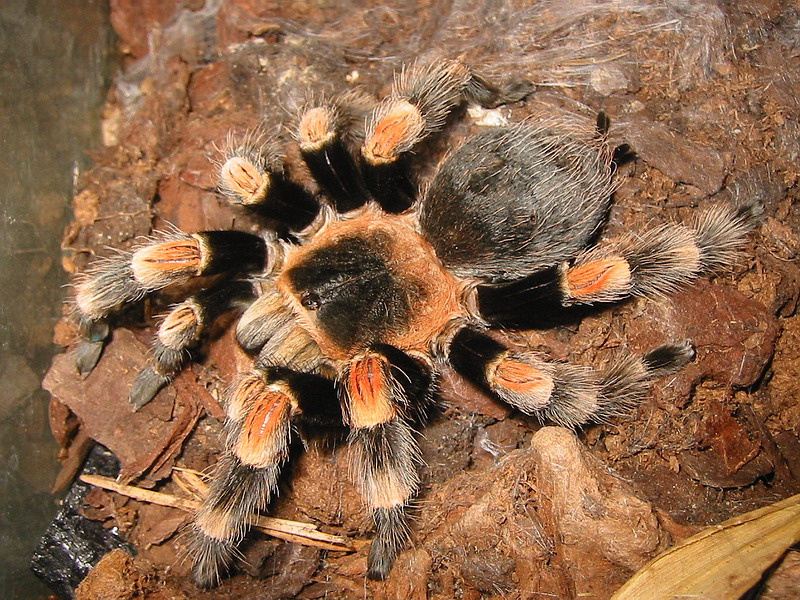
Brachypelma hamorii
| Subfamily | Theraphosinae |
| Origin | Guerrero, Mexico |
| Popularname | Mexican redknee, rödknäad fågelspindel |
| Size | ca 6-7cm bodylength, ca 18cm legspan |
| Temperature | 27-28c |
Entymology
Brachypelma (greek), short + sole (of the foot).
This species was named ”smithi” before a revision of the genus Brachypelma. The former species annitha was synonym to smithi and the smithi we keep in the hobby was infact hamorii.
Introduction
Under 1970-80 this was the most common tarantula in captivity. It was imported in thousands to the pet trade. Today the entire genus Brachypelma are protected by a CITES II listing and wildcaught smithi are not so common anymore in the pet trade. Its bred successfully in Europe and North America so spiderlings are often available.
In the terrarium
A beautiful, hardy and easy to care for that are recommended to the beginner. A normal sized terrarium (30x30x30cm) are enough for this spider. A thick layer of peat is a good substrate. They burrow in the wild but also seek shelter under rocks and other natural objects. In the terrarium they usually dont burrow but sometimes they do, especielly before a molt. Put a piece of cork bark for shelter and a water bowl (and no cotton or similar in the water! It will easily become infested with bacteria). Avoid decorate the cage with stones, sometimes smithi climb around in the cage and if it falls down on a stone the abdomen could rupture. These spiders live in a arid environment but not in a typical sahara desert, more a arid rocky bushy desert. Spray the cage light once a week or so, especielly at a upcoming molt.
Food
Give it insects such as crickets, cockroaches and grasshoppers. The size of the prey should be adjusted to the size of the spider. Small spiderlings can be fed with small newly hatched crickets, or a larger prekilled cricket (if you cannot get hold of any tiny ones). Give a adult spider food 1-2 times a week, spiderlings a few times more. If the spider refuse to eat there can be a molt coming up, smaller spiders refuses food around a week before the acctual molt and larger spiders 2 weeks or more. Many dry living species, especially from North America can have periods when they dont eat as much but as long as the abdomen looks round and healthy there’s no need to worry. If the spiderlings are fed properly and kept warm, they reach maturity in 4-5 years, the females somewhat longer. Look for a private breeder to get a healthy smithi along with good information. The males have a shorter longevity then the females, but if you buy a young female smithi you can have her around for the next 20 years or more!
Handling
The temperament varies a bit in this species, some may be very calm while others are more nervous and flick the urticating hairs at the slightest disturbance. These hairs itch and if they get into the the throat or nose it can be torture! Theraphosids from the new world got those hairs in common (with a few exceptions), and its a effective defense against predators. The hairs are located on the abdomens upperside and the spider kick them off by rubbing the tarsus over them. All tarantulas are venomous, even if there are no documented cases of a human fatality due to a tarantula bite, you should be careful anyway. You can get a allergic reaction of the venom and you never know until the accident happens. Avoid accidents by avoiding to handle the tarantula with your hands. You might get bitten and the spider can get injured if it falls to the ground when handled.
References
Mendoza, J. I. & Francke, O. F. (2017). Systematic revision of Brachypelma red-kneed tarantulas (Araneae: Theraphosidae), and the use of DNA barcodes to assist in the identification and conservation of CITES-listed species. Invertebrate Systematics 31(2): 157-179.
Distribution and Natural History of Mexican Species of Brachypelma and Brachypelmides
A. Locht, M. Yanez and I. Vazquez – JOURNAL OF ARACHNOLOGY, 1999
